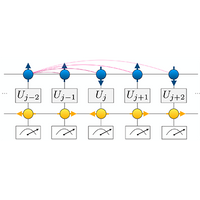Abstract
Quantum critical systems constitute appealing platforms for exploring novel measurement-induced phenomena due to their innate sensitivity to perturbations. We study the impact of measurements on paradigmatic Ising quantum-critical chains using an explicit protocol, whereby correlated ancillae are entangled with the critical chain and then projectively measured. Using a perturbative analytic framework supported by extensive numerical simulations, we demonstrate that measurements can qualitatively alter critical correlations in a manner dependent on the choice of entangling gate, ancilla measurement basis, measurement outcome, and nature of ancilla correlations. We further show that measurement-altered Ising criticality can be pursued surprisingly efficiently in experiments featuring of order 100 qubits by postselecting for high-probability measurement outcomes or, in certain cases, by averaging observables separately over measurement outcomes residing in distinct symmetry sectors. Our framework naturally adapts to more exotic quantum-critical points and highlights opportunities for realization in noisy intermediate-scale quantum hardware and in Rydberg arrays.
15 More- Received 23 February 2023
- Accepted 20 October 2023
DOI:https://doi.org/10.1103/PhysRevX.13.041042
Published by the American Physical Society under the terms of the Creative Commons Attribution 4.0 International license. Further distribution of this work must maintain attribution to the author(s) and the published article’s title, journal citation, and DOI.
Published by the American Physical Society
Physics Subject Headings (PhySH)
Popular Summary
Measurements play a fundamental role in quantum mechanics, spurring some of the most famous conundrums in physics. In the modern era, measurements can not only probe quantum systems, but also generate novel phenomena ranging from entanglement phase transitions to efficient preparation of exotic ground states. In this work, we extend measurement-induced phenomena into new, experimentally relevant territory by uncovering a remarkably rich interplay between measurements and correlations emerging at certain quantum phase transitions that arise in myriad settings.
Specifically, we study 1D Ising phase transitions, which display universal fluctuations that arise when a collection of spins is tuned to a critical point between ferromagnetic and nonmagnetic states of matter. We explore a protocol—amenable to both experiment and theoretical methods—that weakly entangles an Ising critical system to auxiliary qubits and then measures the latter. This procedure “weakly” measures the critical degrees of freedom, yielding behavior that strikingly transcends the conventional Ising transition paradigm.
Conventionally in 1D Ising transitions, the microscopic constituents exhibit power-law correlations with rigid decay exponents that do not depend on any system details. In our procedure, depending on the particulars of the auxiliary system, measurements can instead yield continuously variable power-law exponents, or catalyze magnetic ordering. These effects can be revealed efficiently in experiments of order 100 qubits by either postselecting for high-probability measurement outcomes or, in certain cases, by averaging observables separately over measurement outcomes residing in distinct symmetry sectors.
Our results deepen the understanding of measurement-altered quantum criticality and offer practical guidelines for experimental investigations in current quantum computing hardware and Rydberg atom arrays.



